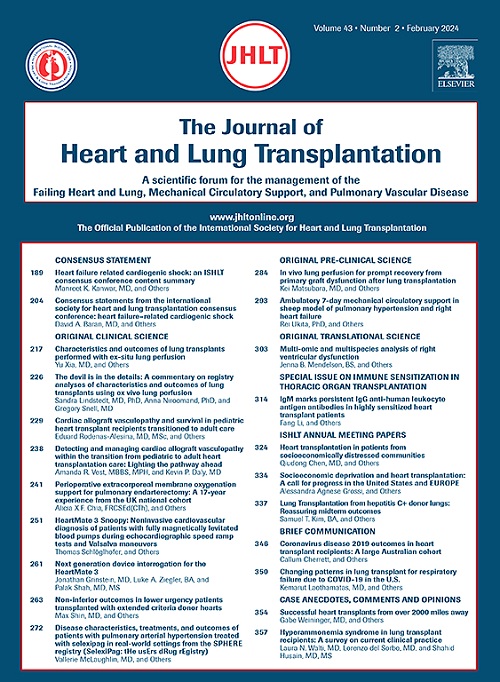肺移植受者治疗性霉酚酸监测的综合采样策略
IF 6.4
1区 医学
Q1 CARDIAC & CARDIOVASCULAR SYSTEMS
引用次数: 0
摘要
背景霉酚酸(MPA)是肺移植中最常用的抗增殖药物,但其药代动力学(PK)变异性阻碍了治疗药物的监测。遗传和临床因素都与 MPA 的变异性有关。本研究旨在将遗传和临床因素与 PK 测量相结合,以量化 MPA 暴露。我们对以前与 MPA 代谢相关的 SLCO1B3 多态性进行了基因分型,并收集了相关的临床数据。我们计算了曲线下面积(AUC0-12),并进行了单变量线性回归分析,以评估其与遗传、临床和药代动力学变量的关联。结果仅在 MPA 给药后 2、3 和 8 小时进行的测量(C2、C3 和 C8)与 MPA AUC0-12 密切相关(R 分别为 267%、67% 和 68%)。与 MPA AUC0-12 相关的临床和遗传因素包括 MPA 剂量(p = 0.001)、移植诊断(p = 0.015)、SLCO1B3 基因型(p = 0.049)和体表面积(p = 0.050)。结论与纯 PK 模型相比,MPA 的综合 LSS 可提高 MPA AUC0-12 预测的准确性。该模型的验证将使临床上可行的 MPA 治疗药物监测成为可能,并有助于推进 MPA 的精准管理。本文章由计算机程序翻译,如有差异,请以英文原文为准。
An integrated sampling strategy for therapeutic mycophenolic acid monitoring in lung transplant recipients
Background
Mycophenolic Acid (MPA) is the most used anti-proliferative in lung transplantation, but its pharmacokinetic (PK) variability has precluded therapeutic drug monitoring. Both genetic and clinical factors have been implicated in MPA variability. This study aimed to integrate genetic and clinical factors with PK measurements to quantify MPA exposure.
Methods
We performed 12-hour pharmacokinetic analysis on 60 adult lung transplant recipients maintained on MPA for immunosuppression. We genotyped a SLCO1B3 polymorphisms previously associated MPA metabolism and collected relevant clinical data. We calculated area under the curve (AUC0–12) and performed univariate linear regression analysis to evaluate its association with genetic, clinical, and pharmacokinetic variables. We performed lasso regression analysis to create final AUC estimation tools.
Results
PK-only measurements obtained 2, 3, and 8 hours after MPA administration (C2, C3, and C8) were strongly associated with MPA AUC0–12 (R2 67%, 67% and 68% respectively). Clinical and genetic factors associated with MPA AUC0–12 included the MPA dose (p = 0.001), transplant diagnosis (p = 0.015), SLCO1B3 genotype (p = 0.049), and body surface area (p = 0.050). The best integrated single-sampling strategy included C2 and achieved an R2 value of 80%. The best integrated limited-sampling strategy included C0, C0.25, and C2 and achieved an R2 value of 90%.
Conclusions
An integrated limited sampling strategy (LSS) for MPA allows increased accuracy in prediction of MPA AUC0–12 compared to PK-only modeling. Validation of this model will allow for clinically feasible MPA therapeutic drug monitoring and help advance precision management of MPA.
求助全文
通过发布文献求助,成功后即可免费获取论文全文。
去求助
来源期刊
CiteScore
10.10
自引率
6.70%
发文量
1667
审稿时长
69 days
期刊介绍:
The Journal of Heart and Lung Transplantation, the official publication of the International Society for Heart and Lung Transplantation, brings readers essential scholarly and timely information in the field of cardio-pulmonary transplantation, mechanical and biological support of the failing heart, advanced lung disease (including pulmonary vascular disease) and cell replacement therapy. Importantly, the journal also serves as a medium of communication of pre-clinical sciences in all these rapidly expanding areas.

 求助内容:
求助内容: 应助结果提醒方式:
应助结果提醒方式:


